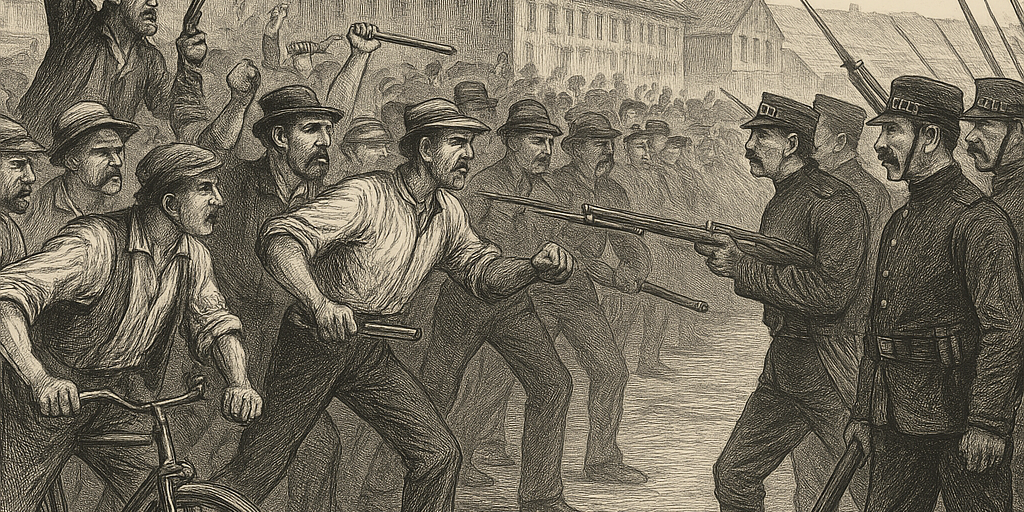Inside the Homestead Strike of 1892: Labor’s Bloody Stand
In the summer of 1892, the steel town of Homestead, Pennsylvania, erupted into one of the most dramatic and violent labor conflicts in American history. The Homestead Strike wasn’t just a battle over wages or working conditions—it was a fierce confrontation over the very future of organized labor in the United States. Set against the backdrop of Gilded Age industrialization, this brutal struggle between steelworkers and industrialists captured the nation’s attention and left a lasting imprint on labor relations in Pittsburgh and beyond.
Setting the Stage: Gilded Age Pittsburgh
By the late 19th century, Pittsburgh had cemented its place as the steel capital of the world. Its towering mills thundered day and night, churning out the rails, beams, and girders that fueled America’s rapid expansion. This industrial boom, explored in depth in the story of how the steel industry shaped Pittsburgh, brought both prosperity and peril to the region.
At the heart of this empire was Andrew Carnegie’s Homestead Works, a sprawling complex along the Monongahela River that stood among the most advanced steel plants of its time. But behind the smoke and steel was a brutal reality: workers endured 12-hour shifts, seven days a week, surrounded by deafening machines, blistering heat, and constant danger.
The Amalgamated Association: A Union with Teeth
Founded in 1876, the Amalgamated Association of Iron and Steel Workers (AA) represented skilled steelworkers across the nation. At Homestead, the AA had negotiated favorable contracts for its members, wielding significant influence within the mill.
But Andrew Carnegie and his business partner, Henry Clay Frick, believed the union was an impediment to efficiency and profit. While Carnegie publicly supported labor rights, he quietly encouraged Frick to break the union when their current contract expired in 1892.
Frick’s Iron Hand: Fortifying the Mill
As the June 30 contract deadline approached, tensions at the Homestead Works reached a boiling point. Henry Clay Frick—a ruthless executive known for his uncompromising stance on labor—took the offensive. As detailed in his controversial legacy, Frick believed that unions were obstacles to efficiency and profit. He ordered the construction of a massive barricade around the mill, quickly nicknamed “Fort Frick,” complete with barbed wire, searchlights, and sniper towers.
To enforce the lockout and break the union, Frick hired 300 armed Pinkerton agents. His plan was simple and brutal: shut the workers out—and if necessary, crush the strike by force.
July 6, 1892: A Bloody Day on the River
In the early hours of July 6, two barges carrying Pinkerton agents floated down the Monongahela River toward Homestead. Thousands of steelworkers and townspeople had been alerted and lined the riverbanks. As the agents attempted to disembark, gunfire erupted. For over 12 hours, a pitched battle raged.
Workers armed with rifles and even a homemade cannon fired from rooftops and behind barricades. The Pinkertons responded with return fire. By the time the agents surrendered, nine strikers and seven Pinkertons were dead, and dozens more were wounded.
The Aftermath: Occupying the Town
With the Pinkertons defeated and paraded through the streets in shame, the workers briefly controlled the mill. Homestead became a national symbol of labor defiance. But the victory was short-lived.
Pennsylvania Governor Robert Pattison, pressured by Frick and other industrialists, dispatched 8,500 state militia troops to Homestead. The town was occupied, the mill reopened with strikebreakers, and martial law effectively squashed the union’s control.
Anarchist Violence: The Berkman Assassination Attempt
The strike took a darker turn when Alexander Berkman, an anarchist and sympathizer with the workers, traveled to Pittsburgh and attempted to assassinate Frick on July 23. Berkman entered Frick’s office and shot him twice and stabbed him, but Frick survived.
While Berkman acted independently, the attack discredited the strike movement in the eyes of the public. Labor leaders condemned the violence, but the damage to their cause was already done.
The Collapse of the Strike
With morale crumbling and families struggling to survive without wages, the Homestead Strike officially ended on November 20, 1892. The union was broken. Most workers returned under worse conditions than before. The AA would never regain its power in the steel industry.
Legacy: Labor’s Turning Point
The Homestead Strike marked a pivotal moment in American labor history. It demonstrated the limits of union power in the face of organized corporate resistance. It also set the stage for future labor movements to focus on broader political and legislative change.
Despite its failure, the courage of the Homestead workers inspired generations of labor activists. It remains a symbol of working-class resistance in Pittsburgh’s history.
Remembering Homestead Today
Today, the once-mighty Homestead Works is almost entirely gone, its smokestacks and steel mills replaced by modern retail stores, chain restaurants, and movie theaters at The Waterfront shopping center. On the surface, it’s hard to imagine that this stretch of riverfront was once the site of one of the bloodiest labor battles in American history. But for those who look closer, the echoes of 1892 are still present.
Just a short walk from the shopping complex stands the Pump House—a sturdy brick building that once regulated water for the steel plant and now serves as one of the last remaining witnesses to the violence of that July day. It was here that striking workers fired their first shots at the approaching Pinkertons on the Monongahela River. Today, the Pump House has been preserved as a memorial, its weathered exterior and interpretive signage reminding visitors of the courage and desperation that once boiled over on these grounds.
Historical tours, plaques, and the efforts of local museums help ensure that the legacy of the Homestead Strike isn’t lost amid the modern storefronts and parking lots. Organizations like the Rivers of Steel Heritage Corporation continue to educate the public about the strike’s significance—not just as a local tragedy, but as a pivotal chapter in the national story of labor rights. Visitors can explore the surrounding area, visit exhibits, and even stand on the riverbank where workers once gathered to defend their livelihoods.
The story of the Homestead Strike lives on as a sobering reminder of the human cost of unchecked industrial ambition—and the bravery of those who dared to resist it. It’s a legacy not only of conflict, but of community, solidarity, and the enduring fight for dignity in the workplace.









